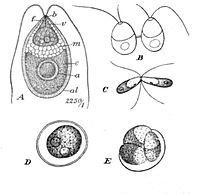
Photo from wikipedia
Dunaliella salina biotechnology is a fast-growing area relying mostly on biomass yield and s-carotene accumulation which might be reached up to 10% of the microalgal cell dry weights. Micro and… Click to show full abstract
Dunaliella salina biotechnology is a fast-growing area relying mostly on biomass yield and s-carotene accumulation which might be reached up to 10% of the microalgal cell dry weights. Micro and macroelements concentration in the culture environment plays a great role in s-carotene and biomass productivity in D. salina. Here, we investigated the influences of different phosphorous, and nitrogen concentrations, on s-carotene and biomass production in D. salina. Besides, the concentration of other important macromolecules including proteins, lipids and also carbohydrates were measured in each cultivation mode in nutrient rich or nutrient starved media. Phosphorous and nitrogen limitation brought a significant reduction (48.49%) in biomass production after simultaneous phosphorous and nitrogen deprivation in D. salina culture during 28 days of experiment. Moreover, the s-carotene accumulation level was interestingly elevated (11.080 mg L-1 in nitrogen starvation, and 14.614 mg L-1 in double phosphorous and nitrogen depleted medium) in comparison with its preliminary levels (6.615 mg L-1) in the Johnson culture medium. The results confirmed the possibility of bioprocess engineering approach based upon nutrient rich media at the first cultivation stage and then nutrient depletion strategy at the second step to maximize the s-carotene accumulation amounts in D. salina with the minimum biomass reduction. The operational conditions should be optimized for scale up studies
Journal Title: Research Journal of Pharmacy and Technology
Year Published: 2018
Link to full text (if available)
Share on Social Media: Sign Up to like & get
recommendations!